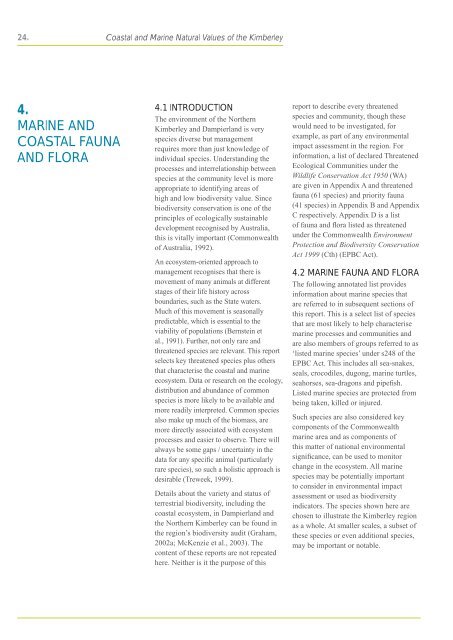coastal and marine natural values of the kimberley - wwf - Australia
coastal and marine natural values of the kimberley - wwf - Australia
coastal and marine natural values of the kimberley - wwf - Australia
You also want an ePaper? Increase the reach of your titles
YUMPU automatically turns print PDFs into web optimized ePapers that Google loves.
24. Coastal <strong>and</strong> Marine Natural Values <strong>of</strong> <strong>the</strong> Kimberley4.MARINE ANDCOASTAL FAUNAAND FLORA4.1 INTRODUCTIONThe environment <strong>of</strong> <strong>the</strong> Nor<strong>the</strong>rnKimberley <strong>and</strong> Dampierl<strong>and</strong> is veryspecies diverse but managementrequires more than just knowledge <strong>of</strong>individual species. Underst<strong>and</strong>ing <strong>the</strong>processes <strong>and</strong> interrelationship betweenspecies at <strong>the</strong> community level is moreappropriate to identifying areas <strong>of</strong>high <strong>and</strong> low biodiversity value. Sincebiodiversity conservation is one <strong>of</strong> <strong>the</strong>principles <strong>of</strong> ecologically sustainabledevelopment recognised by <strong>Australia</strong>,this is vitally important (Commonwealth<strong>of</strong> <strong>Australia</strong>, 1992).An ecosystem-oriented approach tomanagement recognises that <strong>the</strong>re ismovement <strong>of</strong> many animals at differentstages <strong>of</strong> <strong>the</strong>ir life history acrossboundaries, such as <strong>the</strong> State waters.Much <strong>of</strong> this movement is seasonallypredictable, which is essential to <strong>the</strong>viability <strong>of</strong> populations (Bernstein etal., 1991). Fur<strong>the</strong>r, not only rare <strong>and</strong>threatened species are relevant. This reportselects key threatened species plus o<strong>the</strong>rsthat characterise <strong>the</strong> <strong>coastal</strong> <strong>and</strong> <strong>marine</strong>ecosystem. Data or research on <strong>the</strong> ecology,distribution <strong>and</strong> abundance <strong>of</strong> commonspecies is more likely to be available <strong>and</strong>more readily interpreted. Common speciesalso make up much <strong>of</strong> <strong>the</strong> biomass, aremore directly associated with ecosystemprocesses <strong>and</strong> easier to observe. There willalways be some gaps / uncertainty in <strong>the</strong>data for any specific animal (particularlyrare species), so such a holistic approach isdesirable (Treweek, 1999).Details about <strong>the</strong> variety <strong>and</strong> status <strong>of</strong>terrestrial biodiversity, including <strong>the</strong><strong>coastal</strong> ecosystem, in Dampierl<strong>and</strong> <strong>and</strong><strong>the</strong> Nor<strong>the</strong>rn Kimberley can be found in<strong>the</strong> region’s biodiversity audit (Graham,2002a; McKenzie et al., 2003). Thecontent <strong>of</strong> <strong>the</strong>se reports are not repeatedhere. Nei<strong>the</strong>r is it <strong>the</strong> purpose <strong>of</strong> thisreport to describe every threatenedspecies <strong>and</strong> community, though <strong>the</strong>sewould need to be investigated, forexample, as part <strong>of</strong> any environmentalimpact assessment in <strong>the</strong> region. Forinformation, a list <strong>of</strong> declared ThreatenedEcological Communities under <strong>the</strong>Wildlife Conservation Act 1950 (WA)are given in Appendix A <strong>and</strong> threatenedfauna (61 species) <strong>and</strong> priority fauna(41 species) in Appendix B <strong>and</strong> AppendixC respectively. Appendix D is a list<strong>of</strong> fauna <strong>and</strong> flora listed as threatenedunder <strong>the</strong> Commonwealth EnvironmentProtection <strong>and</strong> Biodiversity ConservationAct 1999 (Cth) (EPBC Act).4.2 MARINE FAUNA AND FLORAThe following annotated list providesinformation about <strong>marine</strong> species thatare referred to in subsequent sections <strong>of</strong>this report. This is a select list <strong>of</strong> speciesthat are most likely to help characterise<strong>marine</strong> processes <strong>and</strong> communities <strong>and</strong>are also members <strong>of</strong> groups referred to as‘listed <strong>marine</strong> species’ under s248 <strong>of</strong> <strong>the</strong>EPBC Act. This includes all sea-snakes,seals, crocodiles, dugong, <strong>marine</strong> turtles,seahorses, sea-dragons <strong>and</strong> pipefish.Listed <strong>marine</strong> species are protected frombeing taken, killed or injured.Such species are also considered keycomponents <strong>of</strong> <strong>the</strong> Commonwealth<strong>marine</strong> area <strong>and</strong> as components <strong>of</strong>this matter <strong>of</strong> national environmentalsignificance, can be used to monitorchange in <strong>the</strong> ecosystem. All <strong>marine</strong>species may be potentially importantto consider in environmental impactassessment or used as biodiversityindicators. The species shown here arechosen to illustrate <strong>the</strong> Kimberley regionas a whole. At smaller scales, a subset <strong>of</strong><strong>the</strong>se species or even additional species,may be important or notable.
















